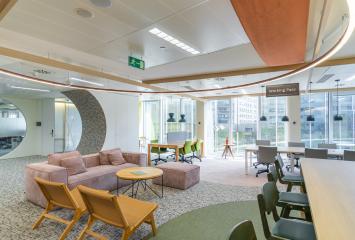Maximalist architecture: the new trend for offices
The early years of the 21st century have been marked by the predominance of minimalism, especially in architecture and interior design. The premise was very simple: less is more. This idea has influenced homes, public spaces, and, of course, businesses. However, the current environment seems to be moving in the opposite direction: experts and architectural firms are increasingly discussing maximalist architecture, a counter-proposal with very different aesthetic and fundamental values, but with significant benefits for both individuals and organizations.
Characteristics of maximalist architecture
Maximalist architecture is, above all, a celebration of excess. The basic geometric forms of minimalism are transformed into much more creative shapes, turning the office into a more fun, dynamic, and lively space. This approach, say those who view architecture from a neurological perspective, stimulates imagination and enhances innovation within companies. But it’s not just about the shapes: maximalism tends to use vibrant colors and bold patterns that give spaces a lot of personality, helping employees identify with them. It boosts the culture of each company.
Moreover, unlike the minimalist emphasis on open space, maximalism abounds with decorative elements. These include architectural features like elaborate moldings or extravagant borders, as well as interior design elements like paintings, sculptures, or textiles. Maximalist spaces typically feature a wide variety of textures, ranging from carved wood and exposed brick to velvet, wool, or plastic. In a sense, maximalism borders on eclecticism, creating lively environments that seem unplanned down to the last detail.
Finally, and although this is more related to design than architecture itself, the maximalist office favors large, elaborate furniture with intricate details. It’s common to find highly adorned tables, striking lamps, richly colored upholsteries, and a wide variety of seating. The premise here is also simple: more is more, as it fosters warmth, visual freedom, and healthy individuality. In fact, promoting individuality is one of the main benefits of maximalism. It allows for the addition of elements without the constraints typical of minimalism or classicism. But there are many more benefits as well.
More benefits of maximalist architecture
The lack of strict restrictions makes maximalist architecture a goldmine of opportunities for architects, designers, and the workers who occupy the space. Personal expression is highly valued, and individual tastes stand out. It is also a way for organizations to visually stimulate those working in their offices. After all, all these inputs inspire and encourage thinking in less orthodox ways. This is probably the greatest benefit of maximalism for businesses: it makes it easier to generate groundbreaking ideas. These ideas are game-changers. They are worth gold.
Moreover, the maximalist office is opulent and often leaves a great impression on visitors, which is very relevant when trying to attract potential clients. These environments are memorable and help associate the company with positive eccentricity. After all, clients seek solutions that others cannot provide. Finally, it is worth emphasizing the familiarity that maximalist offices convey to workers and visitors, leading to a greater sense of belonging, emotional stability, and consequently, higher performance.

